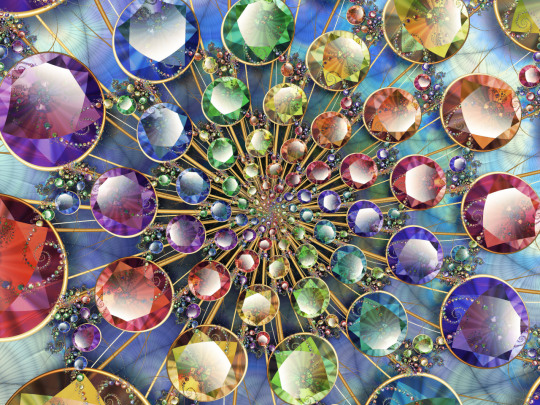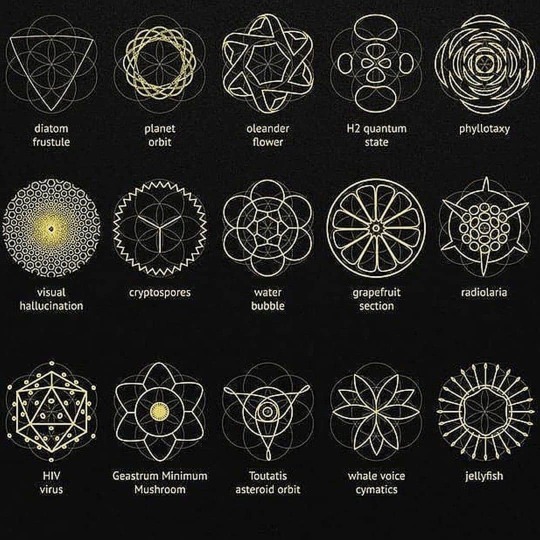#phyllotaxis
Explore tagged Tumblr posts
Text

White Rabbit on the Road to Baguio — Johanna Poethig
Painting (acrylic), 42" x 53" x 1.5"
Presented at The deYoung Open 2023 (ID #169)
Listed for $4500 *
Artist statement:
On a road stop along the steep mountain pass to Baguio City in the 1950s I ask for candy from an unwilling Ifugao girl. The classic White Rabbit candy from China crosses generations and cultures, still popular in the 21st century, floats with the ancient bronze amulet of the Ifugao in the visual stream of this childhood encounter. The two children stand in a field of phyllotaxis algorithmic patterns that embody the life systems that sustain us. This painting is a moment of innocence steeped in Philippine and US colonial history. My work encompasses memory, culture, politics and the natural environment mixing abstraction, figuration and symbol and some humor in this visual narrative.
Johanna Poethig is a visual and performance artist based in California. To learn more about her work and to view her other creations, visit johannapoethig.com . You can also find her on Instagram @johannapoethigsilver .
The deYoung Open is a triannual exhibition featuring artwork by California-Bay Area creators. The most recent exhibit was on display at The deYoung Museum in San Francisco from 09/30/2023 to 01/07/2024. To learn more and view a digital gallery of all 883 pieces that were featured, visit deyoungopen.artcall.org . And if you're an artist from Alameda, Contra Costa, Marin, Napa, San Francisco, San Mateo, Santa Clara, Solano, or Sonoma County, you should consider making a submission for 2026! Applications will probably go live in early June 2026, so you have some time to plan :)
I am not an affiliate of The deYoung Museum, Johanna Poethig, or any of the artists featured in The deYoung Open 2023. I'm just posting to celebrate some amazing CA artists. If you are the artist and would like me to take this post down or add additional credit, please message me on Tumblr.
* Listing price is shown on the deYoung Open website at time of writing. The artwork may no longer be available for sale.
#The deYoung Open 2023#White Rabbit on the Road to Baguio#Johanna Poethig#art#phyllotaxis#acrylic painting#painting#philippines#ph#california artist#bay area artist#california#bay area#san francisco#the deyoung museum
1 note
·
View note
Photo

Gemstones, 2017
3 notes
·
View notes
Video
instagram
Reposted from @jain108academy Phyllotaxis
.
Video credit: unknown, comment for credit . #phyllotaxis #spacetime #interdimensional #dimensions #sacredgeometry #mathematics #geometry #mathart #gif #higherconsciousness #quantumphysics #symbol #platonicsolids #escher #matemáticas #matematicas #science #vortexmath #ilovemath #3d #3dart #spiral #videoart #spiralPhyllotaxis https://www.instagram.com/p/CPZsogKDGfa/?utm_medium=tumblr
#phyllotaxis#spacetime#interdimensional#dimensions#sacredgeometry#mathematics#geometry#mathart#gif#higherconsciousness#quantumphysics#symbol#platonicsolids#escher#matemáticas#matematicas#science#vortexmath#ilovemath#3d#3dart#spiral#videoart#spiralphyllotaxis
0 notes
Photo



#phyllotaxis#flower#3dflowers#colorful#abstract#Abstract3D#geometric#pixel#digital#digitalart#3d#circle
6 notes
·
View notes
Link
#phyllotaxis#fibonacci sequence#golden ratio#nature#botany#plant#plants#science#learning#knowledge#biology
0 notes
Text


Bush honeysuckle, nasty invasive weed in someone's yard but the paired/bilateral growth is pretty cool looking
#plants#photos#wish ppl cared about invasive species!#phyllotaxis#bush honeysuckle#amir honeysuckle#loricera sp.
0 notes
Quote
In botany, phyllotaxis or phyllotaxy is the arrangement of leaves on a plant stem (from Ancient Greek phýllon "leaf" and táxis "arrangement"). Phyllotactic spirals form a distinctive class of patterns in nature.
Wikipedia
24 notes
·
View notes
Photo

Sacred Geometry and Physics are the same thing. ㅤ Mathematics and Geometry forms the structure and dynamics of matter and energy in all scales of our universe. ㅤ Matter is organized through mathematical frequency laws which forms motion and geometrical shapes from the microcosm to the macrocosm. ㅤ All of nature emerges from mathematical codes which were known in the past and considered "sacred" for their generative properties. ㅤ These codes are descriptions of the dynamics of the energy of our source, which is the life giving light of the sun. ㅤ Light has in itself the mathematical code of life which has been known as "Sacred Geometry". ㅤ DM for credit/ removal #SacredGeometry #Physics #Phyllotaxis #GeometryOfMatter #GeometryInNature #Geometry #Nature #Biology #Morphogenesis #Morphology #NaturalGeometry #GeometryInBiology #Mathematics #GeometryOfLife #GeometryOfVirus #GeometryOfFruits #GeometryOfLight #PlatonicSolids #MetatronsCube #FlowetOfLife #Torus #Matrix #IsotropicVectorMatrix #Science (at Vedic Shastras) https://www.instagram.com/p/CA5FZbbnoZt/?igshid=ti42011oymwv
#sacredgeometry#physics#phyllotaxis#geometryofmatter#geometryinnature#geometry#nature#biology#morphogenesis#morphology#naturalgeometry#geometryinbiology#mathematics#geometryoflife#geometryofvirus#geometryoffruits#geometryoflight#platonicsolids#metatronscube#flowetoflife#torus#matrix#isotropicvectormatrix#science
1 note
·
View note
Photo

#phyllotaxis#phyllotaxie#phyllotaxy#oddly satisfying#oddlyfrightening#succulents#succulente#Dodecahedron#procelain#wood#blooming#spyrogif#LOOP#endless loop#perfect loop#plants#plant
541 notes
·
View notes
Text

engraved artificial phyllotaxis
#engraved#artificial#phyllotaxis#circle#circles#green and white#plastic#artists on tumblr#art#art photography#photo art#conceptual photography#conceptual art#readymade#pretentious
1 note
·
View note
Photo

Enjoy the #incredible #nature 's #perfection ! #phyllotaxis #macro (presso Castagnole, Piemonte, Italy)
2 notes
·
View notes
Photo




0 notes
Video
youtube
This is an animation done by my motion graphics studio, Digifootage Channel. I love the natural patterns of sacred geometry here.
#sacred geometry#phyllotaxis#3danimation#3d artist#3d modeling#geometric art#geometry#motion graphics#motion design#mograph#3d animated#3d design#motion designers#surreal CG#cg art#cg motion graphics#surreal CG animation
0 notes
Link
#phyllotaxis#fibonacci sequence#biology#botany#golden ratio#nature#science#knowledge#learning#plants
1 note
·
View note
Video
tumblr
Butterflies
This is a 100% accurate simulation of how butterflies are created in nature. The source code is currently in very bad shape thanks to many experiments that I keep trying, but I promise to put it up once I’ve cleaned it. This can also be turned into a perfectly looping GIF.
0 notes
